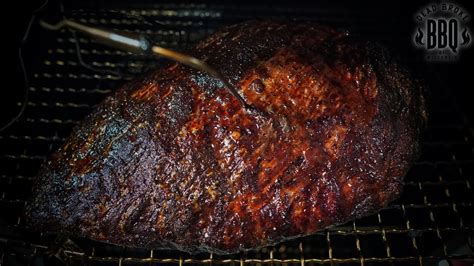How To Get Bark On Brisket In Pellet Smoker
Ronan Farrow
Mar 31, 2025 · 3 min read

Table of Contents
How to Get Bark on Brisket in a Pellet Smoker
Getting that coveted bark on your brisket is the holy grail of low-and-slow smoking. That deeply caramelized, smoky crust is what elevates a good brisket to a legendary brisket. While pellet smokers offer incredible temperature control, achieving perfect bark requires understanding a few key techniques. Let's dive into how to get that beautiful, flavorful bark on your brisket using your pellet smoker.
Understanding Bark Formation
Before we jump into the how-to, let's understand why bark forms. Bark isn't just about looks; it's a crucial element of flavor and texture. It's created through a combination of factors:
- Moisture Evaporation: The initial phase involves the brisket losing moisture. This concentrates the sugars and flavors within the meat.
- Maillard Reaction: As the surface dries, the sugars and amino acids in the meat react at high temperatures, creating the characteristic brown color and delicious flavor compounds. This is the Maillard reaction.
- Smoke Ring: The penetration of smoke into the meat creates the smoke ring, adding another layer of flavor and visual appeal. This happens alongside, not instead of, the Maillard reaction.
Achieving Maximum Bark: Essential Techniques
Here's a breakdown of the key techniques to achieve the ultimate bark on your brisket in a pellet smoker:
1. The Trim: A Clean Canvas
A properly trimmed brisket is crucial. Too much fat inhibits bark formation. Aim for a thin fat cap, about ¼ inch to ½ inch thick. Remove excess fat, but don't go overboard; some fat is necessary for moisture and flavor.
2. Seasoning: Layering the Flavor
Don't skimp on the seasoning! A generous application of your favorite brisket rub is key. Massage the rub into the meat thoroughly, ensuring it adheres to every surface. Consider using a combination of salt, pepper, brown sugar, paprika, garlic powder, and onion powder – but experiment and find what you like best.
3. Temperature Control: Low and Slow is King
Low and slow is the mantra for brisket. Maintain a consistent temperature between 225°F and 250°F (107°C and 121°C) throughout the cook. Avoid drastic temperature swings which can hinder bark development. Your pellet smoker's temperature controller is your best friend here.
4. Smoke Management: The Secret Weapon
While temperature is important, don't neglect your smoker's smoke output. Consistent smoke contributes to both bark and smoke ring development. Make sure your pellet smoker is set to a smoke setting that produces visible smoke throughout the cook.
5. The Wrap (or Not to Wrap): A Controversial Decision
Wrapping your brisket in butcher paper or foil around the stall (a period of stalled temperature increase) helps retain moisture, resulting in a more tender brisket. However, wrapping can also hinder bark development. Experiment to find what works best for you. Some prefer a more pronounced bark and accept a slightly drier brisket, while others prioritize tenderness.
6. The Final Stage: The "Bark Boost"
After unwrapping (if you wrapped), you can consider a "bark boost". Increase the smoker temperature slightly for the last 30-60 minutes of cooking to encourage further caramelization and deepen the bark.
7. Rest is Essential: Patience Pays Off
Once your brisket reaches the desired internal temperature (around 200°F or 93°C), allow it to rest, unwrapped, for at least 2 hours. This allows the juices to redistribute throughout the meat, resulting in a more tender and flavorful brisket with enhanced bark.
Troubleshooting Your Bark
- Pale Bark: May indicate insufficient seasoning, low smoke, or inconsistent temperature.
- Uneven Bark: Check for air leaks in your smoker or uneven seasoning application.
- Dry Bark: You may have cooked at too high a temperature, or not wrapped your brisket correctly.
By following these tips and mastering your pellet smoker, you'll be well on your way to achieving that perfect, mouthwatering bark on your next brisket. Happy smoking!
Featured Posts
Also read the following articles
| Article Title | Date |
|---|---|
| How To Cover A Box With Paper | Mar 31, 2025 |
| How To Crochet Graph | Mar 31, 2025 |
| How To Dry Passion Flower For Tea | Mar 31, 2025 |
| How To Cook Jimmy Nardello Peppers | Mar 31, 2025 |
| How To Get In Wrestling Shape | Mar 31, 2025 |
Latest Posts
-
How Do I Drill A Hole In A Glass Block
Apr 04, 2025
-
How Do I Dispose Of A Dehumidifier Near Me
Apr 04, 2025
-
How Do I Crop An Image In Cricut Design Space
Apr 04, 2025
-
How Do I Contact Hauser
Apr 04, 2025
-
How Do I Choose A Good Neurologist
Apr 04, 2025
Thank you for visiting our website which covers about How To Get Bark On Brisket In Pellet Smoker . We hope the information provided has been useful to you. Feel free to contact us if you have any questions or need further assistance. See you next time and don't miss to bookmark.
